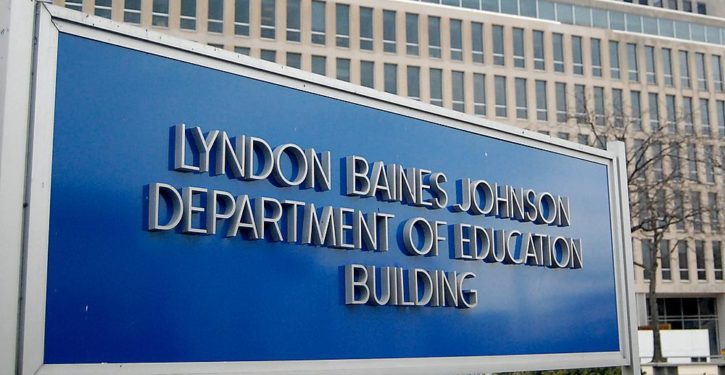
Recently, the Biden administration was reported to have ruled that a school district’s “banning several pornographic books last year was discriminatory against LGBTQ and non-white authors and readers.” But the Forsyth County Schools did not actually discriminate against non-white or LGBTQ authors, and even the Biden administration recognized that the schools did not “target” minority students. Instead, it suggested that the “book screening process” itself potentially violated federal discrimination laws even absent any discriminatory motive, because of things parents said in the debate over school policy.
Should a university or school district be deemed guilty of a “hostile environment” because school officials pursue policies or express opinions that do not target minority students, but lead to some minority students becoming upset? Courts have said no, because this is not “severe or pervasive” enough to create a hostile environment. Indeed, a university president’s public speeches that allegedly exhibited “scorn and hostility” toward students with learning disabilities did not even potentially create a hostile environment, according to a judge in Guckenberger v. Boston University, 957 F.Supp. 306 (D. Mass. 1997). Students’ harassment claim over the president’s speeches was deemed so weak by the judge that it was tossed out at the earliest possible stage of the case. The judge’s ruling reflected the fact that it is usually hard to establish a harassment claim over conduct that is not “directed at” a complainant, as judges have noted.
But the Education Department’s Office for Civil Rights has ignored these court rulings. On May 19, it said that the Forsyth County Schools’ removal of 8 books (7 of them temporarily) from a school library, which admittedly did not “target” minority groups, potentially created a hostile environment in violation of the federal laws Title VI (which bans racial discrimination) and Title IX (which bans sexual discrimination), and thus could constitute discriminatory harassment. As the Daily Caller noted, the “books had graphic depictions of sexual behavior and one, ‘All Boys Aren’t Blue,’ by George Johnson, goes on to describe two boys performing oral sex on each other.” As the Office for Civil Rights (OCR) put it:
OCR has a concern the District received notice that its … book screening process may have created a hostile environment for students, yet the District’s responsive steps related to the book screening process were not designed to, and were insufficient to, ameliorate any resultant racially and sexually hostile environment. OCR recognizes the District Media Committee rejected suggestions to handle challenged books in ways that it believed would target certain groups of students.
It was bizarre for OCR to suggest that this created a racially and sexually hostile environment, because removal of library books does not constitute harassment based on race or sex, and OCR itself admits that the school system did not “target certain groups of students.” Removal of books based on their viewpoint can violate the First Amendment, according to the Supreme Court, but the Office for Civil Rights does not enforce the First Amendment, and removing books about race or gender is not the same as harassment of students based on their race or sex. The laws against discrimination in education — Title VI and Title IX — are narrow, and only cover “intentional discrimination” against students based on race or sex, as the Supreme Court explained in Alexander v. Sandoval (2001).
Even more bizarrely, OCR suggested that students might be so traumatized by the book screening process that they would need “supportive measures,” the way campus rape victims receive “supportive measures” from colleges in the aftermath of a campus rape. To close the investigation, OCR and the school district entered into a resolution agreement:
The Agreement requires the District to issue a statement to students in the District explaining the book removal process and offering supportive measures to students who may have been impacted by the book removal process. The Agreement also requires the District to administer a climate survey of the student bodies at each of the District’s middle and high schools to assess whether additional steps need to be taken.
The Education Department’s suggestion that the race discrimination law Title VI may have been violated was particularly strange, because none of the books removed was removed because of its racial content — all were removed because of their sexual content, and seven of the eight books that were sexually graphic were ultimately returned to school libraries through the normal review process. The one remaining book that was not returned to the library does not need to be returned to the library under the resolution agreement, so it does not even fix any real or imaginary First Amendment violation.
The grounds by which the Education Department contended that the book removals may have constituted a racially hostile environment were that in the process of objecting to sexually explicit books, “some parents made negative comments about diversity and inclusion or critical race theory.” But Title VI is not aimed at promoting “diversity” or “critical race theory,” only at ending racial discrimination, which is not the same thing, as judges explained in Coalition for Economic Equity v. Wilson (1997). The grounds by which it contended that the book removals may have constituted a sexually hostile environment were that “some comments [by parents] focused on removing books for reasons related to gender identity or sexual orientation,” even though “most of their comments focused on sexually explicit content.”
An education scholar at the American Enterprise Institute told me that the precedent that this seems to set is that any school district that temporarily removes a book for review must now send a notice to all students disclaiming racism/sexism/homo/transphobia, and probably offer counseling.
Holding schools liable for parents’ speech in public policy debates seems at odds with First Amendment rulings such as Rodriguez v. Maricopa Community College, 605 F.3d 703 (9th Cir. 2010), which barred offended Hispanic staff from suing for racial harassment over the racially inflammatory anti-immigration emails sent by a white instructor.
One could argue that the book removals made students feel excluded or unwanted. But such vague feelings of alienation don’t rise to the level of a hostile environment, in the eyes of the courts, which reject harassment allegations over conduct that is much worse and far more exclusionary, and don’t give much weight to exclusionary acts that don’t explicitly reference one’s race or gender. For example, a woman lost her harassment lawsuit despite being allegedly frozen “out of important meetings and humiliated at those…she did attend,” in Singh v. U.S. House of Representatives (2004). And a woman lost a lawsuit alleging a hostile environment based on her gender, which cited exclusionary experiences such as not having a locker room for her gender, in Swann v. Office of the Architect of the Capitol (2014).
What happened in the Forsyth County Schools does not remotely violate the Title IX statute. Under Title IX, even recurrent insults or taunts aimed at students based on their sex are usually not grounds for a lawsuit, according to court rulings such as Hawkins v. Sarasota School District (2003). That court decision, by the federal appeals court with jurisdiction over the Forsyth County Schools, rejected a Title IX lawsuit over conduct that was much more offensive, hurtful, and sex-based than what occurred in the Forsyth County Schools in response to its book removal decisions.
Although having sexually-explicit books in the school library does not violate the education law Title IX, which prohibits only “severe AND pervasive” conduct, the workplace is a different matter: If such graphic depictions are seen by school staff, such as librarians, that can create a hostile work environment for school staff under a different law, Title VII of the Civil Rights Act, which forbids workplace conduct that is either “severe OR pervasive,” an easier standard to sue over. (Compare Harris v. Forklift Systems (1993) with Davis v. Monroe Cty Bd. of Education (1999)).
For example, in Stair v. Lehigh Valley Carpenters, a judge found a union liable for sexual harassment solely because its girlie calendars created a hostile environment for a female worker who saw them in her workplace.
The federal Equal Employment Opportunity Commission has repeatedly sued employers that permitted sexually explicit magazines or displays in their workplaces, arguing that a hostile work environment can be created even absent intentional discrimination based on sex.
Thus, the federal government is now sending mixed signals about the presence of sexually-explicit materials. As constitutional lawyer Alison Somin observed:
Progressives: sexually explicit material (posters, magazines) at work may violate Title VII by creating a hostile environment.
Also progressives: removing sexually explicit material from schools may violate Title IX by creating a hostile environment. https://t.co/n8swwhMjFl
— Alison Somin (@AlisonSomin) May 22, 2023.



